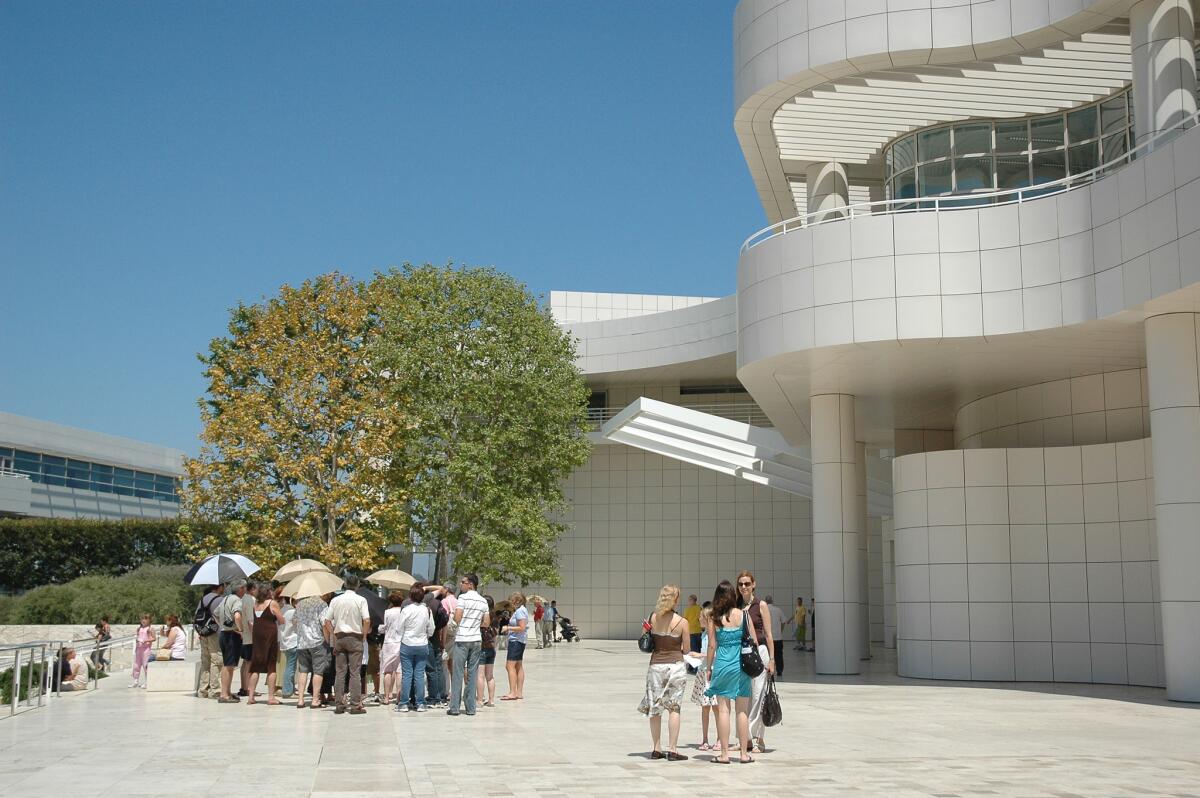Getty endowment rises to $6.2 billion for 2013

This post has been updated. See below for details.
With investment markets booming, the J. Paul Getty Trust, the world’s richest visual art institution, saw its endowment rise to $6.2 billion during 2013, approaching its peak of $6.4 billion in mid-2007 before the Great Recession hit.
An audited financial statement posted on the Getty’s website reflects investment gains totaling $766.74 million from mid-2012 to mid-2013, enough to cover expenses while socking away about $534 million for the endowment. Officials said the endowment gained an additional $300 million during the second half of 2013, reaching $6.2 billion by year’s end.
But even with the good times rolling, the Getty won’t be splurging, President James Cuno said.
GRAPHIC: Highest-earning art executives | Highest-earning conductors
“One makes decisions independent of available resources because one wants to make sure one is spending wisely,” he said.
Patricia Woodworth, the Getty’s chief financial officer, said the core budget for the current 2013-14 fiscal year that ends June 30 is $263 million, up 5.6% from the $249 million spent in 2012-13.
But adjusting for inflation, the Getty’s spending remains about 20% below where it stood at its pre-recession peak in 2007-08.
Woodworth said the Getty had a 13.7% return on its investments during the 2012-13 fiscal year. Nationwide, universities and other institutions averaged an 11.7% return, according to an annual study issued by the National Assn. of College and University Business Officers and the Commonfund Institute.
The Getty’s financial statement shows that the Getty Museum, which includes the hilltop galleries in Brentwood and the Getty Villa antiquities museum in Pacific Palisades, spent $153.6 million in 2012-13, down 3.9% from 2011-12. The Getty’s grant-making wing took a 7.3% cut, down to $29.1 million.
But Cuno said the reductions reflect changes in accounting and normal fluctuations in art acquisitions and grant-making rather than a policy of cutting those divisions. Spending on visitor services and retail operations that previously had been considered museum expenses are now considered general expenses not attached to any of the Getty’s four main branches.
CRITICS’ PICKS: What to watch, where to go, what to eat
The trust’s two other branches, the Getty Research Institute and Getty Conservation Institute, had spending increases in 2012-13 — up 4.9% to $51.7 million for the research institute and a 10.1% hike to $31.6 million for the conservation institute, which tackles global projects to preserve vulnerable artworks or bring them closer to their original condition.
One prominent example is “Mural,” a huge Jackson Pollock canvas that the Getty conserved for its owner, the University of Iowa Art Museum. It will be on display at the Getty Museum through June 1, then sent home.
The Getty also reined in its spending on art acquisitions, from $53 million in 2011-12 to $20.3 million in 2012-13. But Cuno said the Getty in fact has been working to increase its acquisitions spending, and the drop reflected a relative dearth of things it wanted coming on the market, rather than a diminished capacity to buy.
“We’re restoring our acquisitions budget and confident we’ll meet that goal,” he said, declining to give a specific figure because “we don’t want people to focus on the monetary value” of art and because “it’s a competitive world out there and we need to keep confidences” to avoid overspending on acquisitions.
In 2012, the Getty laid off 34 museum employees, primarily in its education department, to free up an additional $4.3 million a year for art acquisitions. Cuno said the Getty is happy with its existing campuses and their state of repair; he foresees no need for big expenditures on deferred maintenance or new construction.
Unlike most museums, which rely heavily on donations and hope to supplement them with investment earnings, the Getty lives almost entirely off its investments — and what the markets give, they can take away.
ART: Can you guess the high price?
Woodworth noted that core spending in 2012-13 was down $4 million from the previous year; tepid investment markets in 2011-12 had dictated reining in spending in the subsequent budget. The Getty’s endowment fell $251.9 million during 2011-12.
The hiring of the Getty’s first chief fundraiser, J. Timothy Child, shortly before the 2012-13 fiscal year began didn’t reap an immediate bonanza, nor was it expected to, Woodworth said.
“Fundraising typically takes a while to build the systems and create the relationships” that lead to substantial gifts, she said. Donations, including the value of gifts of art and research archives, totaled just over $7 million — down from an unusually high $21.3 million in 2011-12, which included the $14-million value of Robert Mapplethorpe’s photographs and archives donated that year by the Mapplethorpe Foundation.
Along with its audited financial statement, which does not give nitty-gritty details such as how much individuals earn, the Getty has posted its annual compensation report for senior management. James Williams, the chief investment officer, earned $1,804,602 during the 2013 calendar year, including a $596,322 “incentive award” based on the trust’s investment performance during the 2012-13 fiscal year. Williams’ incentive earnings had totaled $474,729 in the three previous years combined.
Cuno’s 2013 compensation was $1,388,272, which included a $240,000 housing allowance. Museum Director Timothy Potts earned $829,175, and Chief Financial Officer Woodworth earned $811,529.
Among the Getty’s other department heads, research institute Director Thomas Gaehtgens earned $787,725, including a $78,000 housing allowance, compensation for Deborah Marrow, who heads the grants program, totaled $633,138, and conservation institute Director Tim Whalen earned $621,035.
Update, Saturday, March 15: This story that ran in the Calendar section on March 13 incorrectly overstated the 2013 compensation of several Getty officials. The correct totals are $1,630,956 for chief investment officer James Williams, $1,077,293 for Getty president James Cuno, $766,826 for museum director Timothy Potts, $716,185 for chief financial officer Patricia Woodworth, $645,780 for conservation institute director Thomas Gaehtgens, $528,447 for grants program director Deborah Marrow and $507,708 for conservation institute director Tim Whelan.
More to Read
The biggest entertainment stories
Get our big stories about Hollywood, film, television, music, arts, culture and more right in your inbox as soon as they publish.
You may occasionally receive promotional content from the Los Angeles Times.







